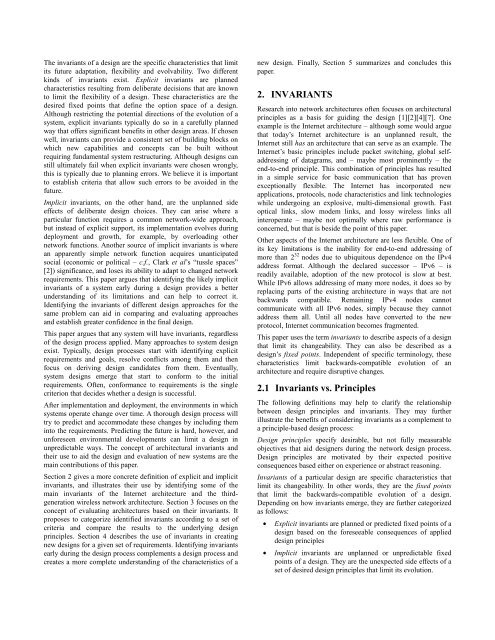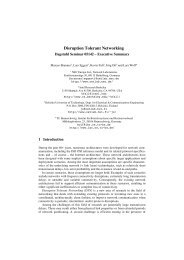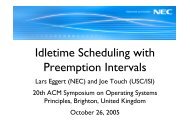A New Design Methodology for Network Architectures - Lars Eggert
A New Design Methodology for Network Architectures - Lars Eggert
A New Design Methodology for Network Architectures - Lars Eggert
You also want an ePaper? Increase the reach of your titles
YUMPU automatically turns print PDFs into web optimized ePapers that Google loves.
The invariants of a design are the specific characteristics that limit<br />
its future adaptation, flexibility and evolvability. Two different<br />
kinds of invariants exist. Explicit invariants are planned<br />
characteristics resulting from deliberate decisions that are known<br />
to limit the flexibility of a design. These characteristics are the<br />
desired fixed points that define the option space of a design.<br />
Although restricting the potential directions of the evolution of a<br />
system, explicit invariants typically do so in a carefully planned<br />
way that offers significant benefits in other design areas. If chosen<br />
well, invariants can provide a consistent set of building blocks on<br />
which new capabilities and concepts can be built without<br />
requiring fundamental system restructuring. Although designs can<br />
still ultimately fail when explicit invariants were chosen wrongly,<br />
this is typically due to planning errors. We believe it is important<br />
to establish criteria that allow such errors to be avoided in the<br />
future.<br />
Implicit invariants, on the other hand, are the unplanned side<br />
effects of deliberate design choices. They can arise where a<br />
particular function requires a common network-wide approach,<br />
but instead of explicit support, its implementation evolves during<br />
deployment and growth, <strong>for</strong> example, by overloading other<br />
network functions. Another source of implicit invariants is where<br />
an apparently simple network function acquires unanticipated<br />
social (economic or political – c.f., Clark et al’s “tussle spaces”<br />
[2]) significance, and loses its ability to adapt to changed network<br />
requirements. This paper argues that identifying the likely implicit<br />
invariants of a system early during a design provides a better<br />
understanding of its limitations and can help to correct it.<br />
Identifying the invariants of different design approaches <strong>for</strong> the<br />
same problem can aid in comparing and evaluating approaches<br />
and establish greater confidence in the final design.<br />
This paper argues that any system will have invariants, regardless<br />
of the design process applied. Many approaches to system design<br />
exist. Typically, design processes start with identifying explicit<br />
requirements and goals, resolve conflicts among them and then<br />
focus on deriving design candidates from them. Eventually,<br />
system designs emerge that start to con<strong>for</strong>m to the initial<br />
requirements. Often, con<strong>for</strong>mance to requirements is the single<br />
criterion that decides whether a design is successful.<br />
After implementation and deployment, the environments in which<br />
systems operate change over time. A thorough design process will<br />
try to predict and accommodate these changes by including them<br />
into the requirements. Predicting the future is hard, however, and<br />
un<strong>for</strong>eseen environmental developments can limit a design in<br />
unpredictable ways. The concept of architectural invariants and<br />
their use to aid the design and evaluation of new systems are the<br />
main contributions of this paper.<br />
Section 2 gives a more concrete definition of explicit and implicit<br />
invariants, and illustrates their use by identifying some of the<br />
main invariants of the Internet architecture and the thirdgeneration<br />
wireless network architecture. Section 3 focuses on the<br />
concept of evaluating architectures based on their invariants. It<br />
proposes to categorize identified invariants according to a set of<br />
criteria and compare the results to the underlying design<br />
principles. Section 4 describes the use of invariants in creating<br />
new designs <strong>for</strong> a given set of requirements. Identifying invariants<br />
early during the design process complements a design process and<br />
creates a more complete understanding of the characteristics of a<br />
new design. Finally, Section 5 summarizes and concludes this<br />
paper.<br />
2. INVARIANTS<br />
Research into network architectures often focuses on architectural<br />
principles as a basis <strong>for</strong> guiding the design [1][2][4][7]. One<br />
example is the Internet architecture – although some would argue<br />
that today’s Internet architecture is an unplanned result, the<br />
Internet still has an architecture that can serve as an example. The<br />
Internet’s basic principles include packet switching, global selfaddressing<br />
of datagrams, and – maybe most prominently – the<br />
end-to-end principle. This combination of principles has resulted<br />
in a simple service <strong>for</strong> basic communication that has proven<br />
exceptionally flexible. The Internet has incorporated new<br />
applications, protocols, node characteristics and link technologies<br />
while undergoing an explosive, multi-dimensional growth. Fast<br />
optical links, slow modem links, and lossy wireless links all<br />
interoperate – maybe not optimally where raw per<strong>for</strong>mance is<br />
concerned, but that is beside the point of this paper.<br />
Other aspects of the Internet architecture are less flexible. One of<br />
its key limitations is the inability <strong>for</strong> end-to-end addressing of<br />
more than 2 32 nodes due to ubiquitous dependence on the IPv4<br />
address <strong>for</strong>mat. Although the declared successor – IPv6 – is<br />
readily available, adoption of the new protocol is slow at best.<br />
While IPv6 allows addressing of many more nodes, it does so by<br />
replacing parts of the existing architecture in ways that are not<br />
backwards compatible. Remaining IPv4 nodes cannot<br />
communicate with all IPv6 nodes, simply because they cannot<br />
address them all. Until all nodes have converted to the new<br />
protocol, Internet communication becomes fragmented.<br />
This paper uses the term invariants to describe aspects of a design<br />
that limit its changeability. They can also be described as a<br />
design’s fixed points. Independent of specific terminology, these<br />
characteristics limit backwards-compatible evolution of an<br />
architecture and require disruptive changes.<br />
2.1 Invariants vs. Principles<br />
The following definitions may help to clarify the relationship<br />
between design principles and invariants. They may further<br />
illustrate the benefits of considering invariants as a complement to<br />
a principle-based design process:<br />
<strong>Design</strong> principles specify desirable, but not fully measurable<br />
objectives that aid designers during the network design process.<br />
<strong>Design</strong> principles are motivated by their expected positive<br />
consequences based either on experience or abstract reasoning.<br />
Invariants of a particular design are specific characteristics that<br />
limit its changeability. In other words, they are the fixed points<br />
that limit the backwards-compatible evolution of a design.<br />
Depending on how invariants emerge, they are further categorized<br />
as follows:<br />
• Explicit invariants are planned or predicted fixed points of a<br />
design based on the <strong>for</strong>eseeable consequences of applied<br />
design principles<br />
• Implicit invariants are unplanned or unpredictable fixed<br />
points of a design. They are the unexpected side effects of a<br />
set of desired design principles that limit its evolution.





